9 Best Places to Visit in Indonesia Beyond Bali
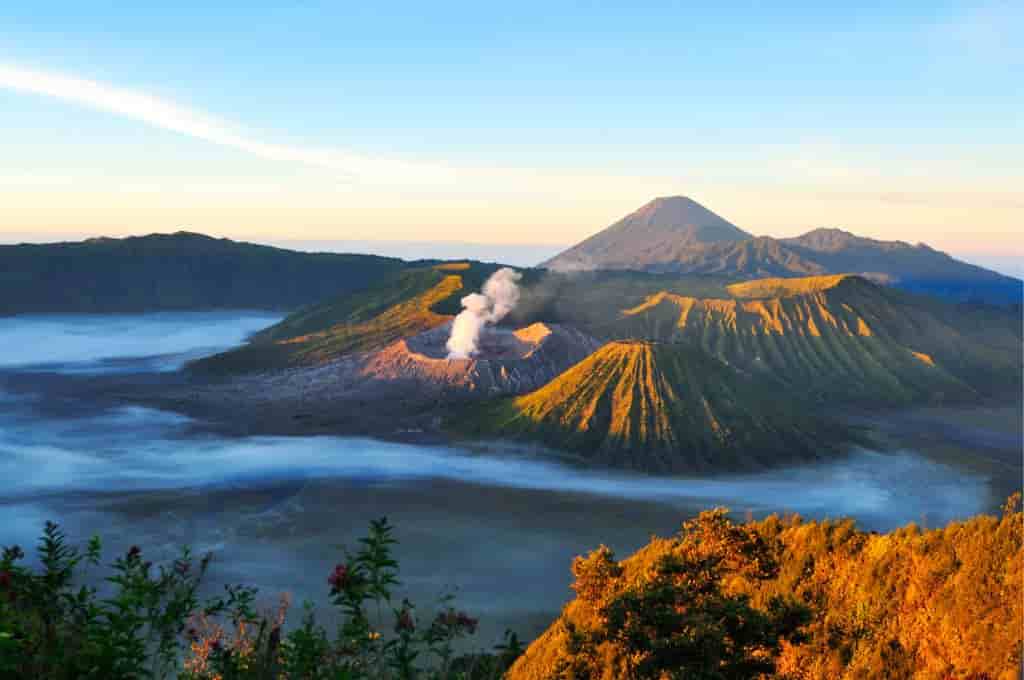
When most people consider visiting Indonesia, they often think of Bali first. With its iconic rice terraces, idyllic beaches, abundance of temples, serene yoga retreats, and bohemian cafes, Bali has long been regarded as a dream destination for backpackers, young travellers, and retreat seekers. However, thousands of islands lie beyond Bali’s borders. Indonesia has more than 17,000 islands, with roughly 6,000 of them inhabited. The gigantic archipelago is packed with breathtaking landscapes, exhilarating experiences, dynamic cultures, and rich biodiversity that often gets overlooked due to Bali’s popularity.
While Bali’s enigmatic charm cannot be denied, discriminating travellers can find a plethora of amazing experiences outside its shores. From remote tropical islands and active volcanoes to ancient temples and wildlife-filled jungles, the sprawling Indonesian archipelago offers an adventure for every kind of explorer. So, if you’re looking for places to visit in Indonesia other than Bali, you’ve come to the right place. Here’s a quick guide to some of the top places to explore in Indonesia, which are just as intriguing and diverse as Bali.
Table of Contents
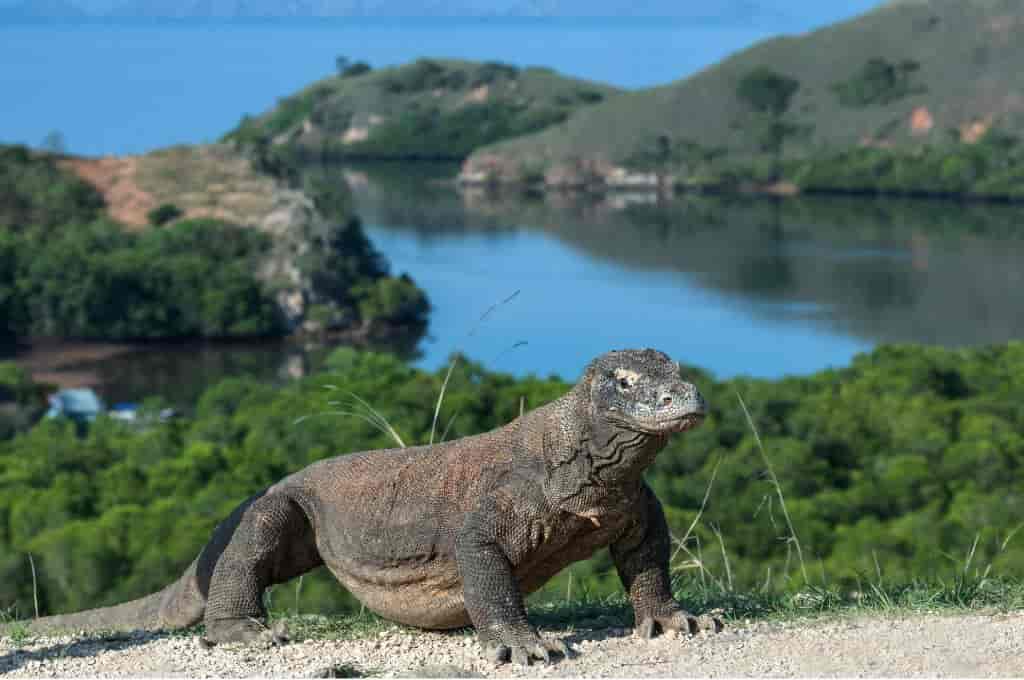
1. Komodo Islands, Indonesia
Komodo Island, located in Indonesia’s Lesser Sunda archipelago, is one of the world’s most ecologically and geologically diverse regions. It offers rich marine biodiversity, a cluster of stunning islands, the ever-popular Pink Beach, and a deep cultural heritage. The rugged island is one of many in Komodo National Park, a UNESCO World Heritage Site known for its Komodo dragons. The world’s largest and heaviest lizard can reach 3 meters in length and weigh more than 70 kilograms. The fork-tongued giants eat almost anything, including their own offspring and human beings. Beyond its famous reptiles, Komodo Island has a rich marine biodiversity, a slew of drool-worthy islands, the ever-popular Pink Beach, and a deep cultural history.
Komodo Islands are situated within the Coral Triangle, one of the world’s most diverse marine ecosystems. The surrounding waters offer excellent snorkelling and diving opportunities, featuring beautiful coral reefs and an eclectic array of exotic marine life, including manta rays, sea turtles, whales, and dolphins. Hike to the panoramic viewpoint on Padar Island, sail along dramatic coastlines, soak up the colours of Pink Beach, dive through vibrant coral gardens, snorkel with manta rays, and, of course, encounter Komodo Dragons in their native home. It would be best to stay in Labuan Bajo, a port town on nearby Flores Island that serves as the launching point for boat cruises across the islands.
Best Time To Visit: The dry season (April-December) is ideal for visiting the Islands.
How to Reach: To reach the island, take a 1.5-hour flight from Bali to Labuan Bajo on Flores Island. Komodo National Park is about a two-hour boat ride from Labuan Bajo town.
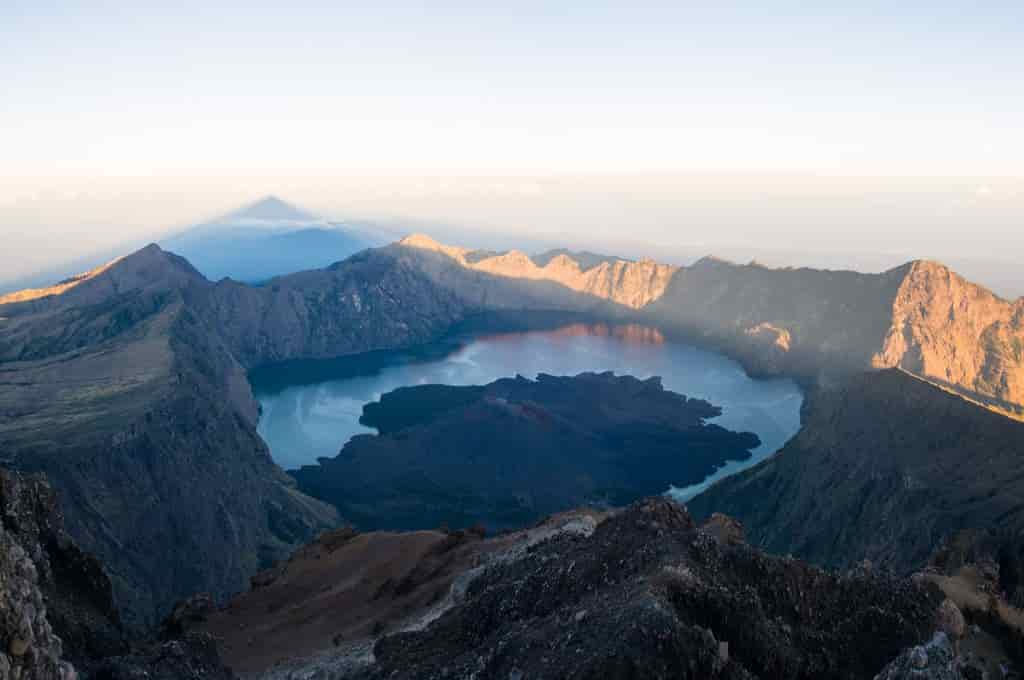
2. Lombok, Indonesia
Lombok, an island in West Nusa Tenggara, is situated just east of Bali and is renowned for its unspoiled beauty, breathtaking landscapes, and authentic local experiences. Often described as a quieter, more laid-back alternative to Bali, Lombok offers powdery beaches, lush forests, cascading waterfalls, and the towering Mount Rinjani, Indonesia’s second-highest volcano. Trekkers from all over take on the challenging multi-day hike to the giant volcano, where they are rewarded with breathtaking views of the Segara Anak crater lake. If you are looking for a respite from the heat, you can swim under pretty waterfalls that dot the island. Jeruk Manis, Semporonan, Benang Stokek, Benang Kelambu, Tiu Kelep, and Sindang Gile Waterfall are the most popular ones.
For beach enthusiasts, the coastline is equally tempting. Visit Selong Belanak, Mawun, Pandanan, or Senggigi to soak up the sun or watch a breathtaking tropical sunset. Lombok’s coastline is lined with surfing hotspots such as Desert Point and Selong Belanak, as well as peaceful bays in the south near Kuta Lombok. The island is home to the indigenous Sasak people, whose traditions, handicrafts, and settlements provide insight into the island’s distinct culture and way of life. Mataram, Lombok’s capital, is perfect for those seeking an upbeat city lifestyle. Lombok also serves as a gateway to the Gili Islands, which enhances its appeal as a tourism hub.
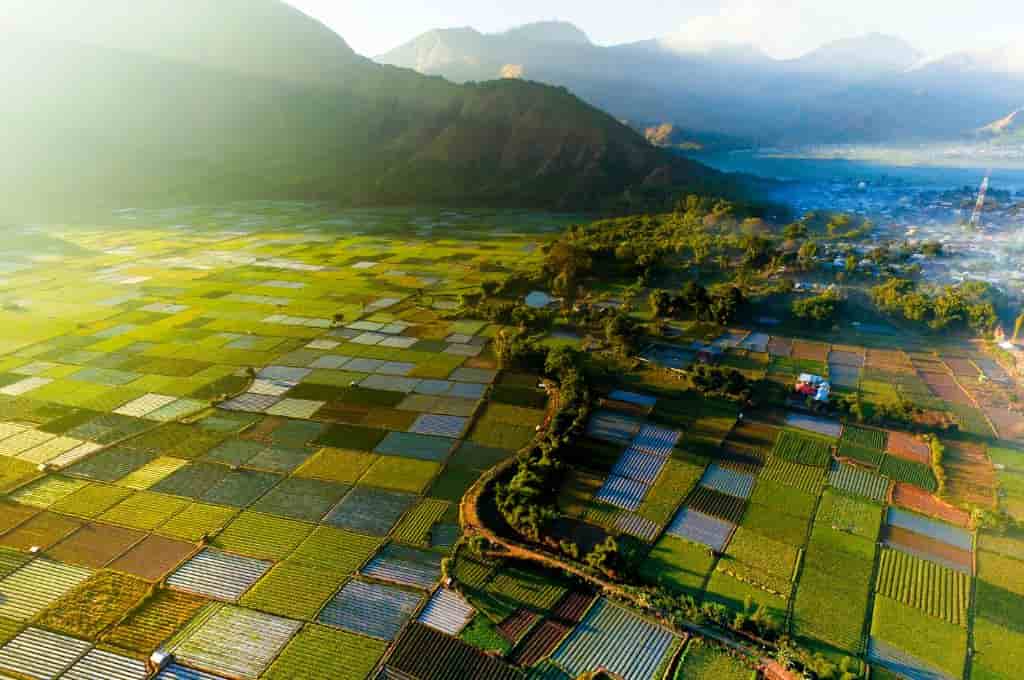
Best Time to Visit: The most popular season to visit Lombok is from May to June, when the days are bright and the temperatures are mild, making it suitable for outdoor activities such as trekking, snorkelling, and surfing.
How to Reach: The most convenient and quickest way to reach Lombok is by plane. Lombok International Airport offers daily direct flights from Jakarta and Bali, with ticket prices generally being affordable. If you’re arriving from Bali, you have three options: a plane, a speedboat, or a public ferry. Boats sail from Padang Bai Harbour in Bali and take you to Lembar Harbour in Lombok. A speedboat takes 1.5 hours, whereas a public ferry can take up to 5 hours.
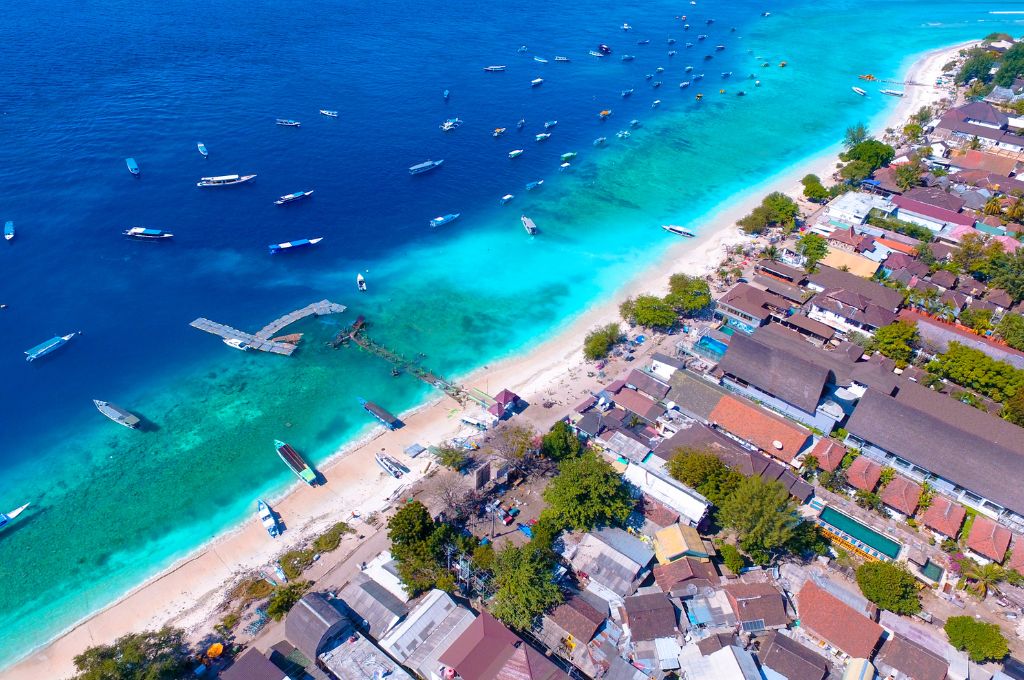
3. Gili Islands, Indonesia
The Gili Islands are a group of three small, scenic islands off the northwest coast of Lombok, Indonesia. Surrounded by white sand beaches and kissed by aquamarine waters, the islands are breathtakingly beautiful. Known for healthy food restaurants, vibrant coral reefs, world-class diving schools, and epic beach parties, the islands cater to all types of travellers. Each island has its own unique character and personality. Gili Trawangan is the largest and most developed, boasting a lively party scene that attracts young backpackers. It’s also an excellent spot for scuba diving courses. Gili Meno, sandwiched in the middle, offers a tranquil, laid-back experience perfect for honeymooners and those seeking seclusion. Secluded beaches, swaying palms, saltwater lakes, and pristine snorkelling spots are the main draws.
With a blend of tranquil retreats and modest touristy infrastructure, Gili Air provides the best of both worlds. The relaxed vibes, beach cafés, yoga studios, diving clubs, and easy access to snorkelling sites right off the shore make it a popular beach getaway. What distinguishes the Gilis is the total lack of motorized vehicles—transportation is limited to bicycles and horse-drawn carts (Cidomo), preserving the peaceful ambiance. The islands offer some of Indonesia’s best snorkelling and diving, with abundant marine life including sea turtles, reef sharks, and a diverse array of vibrant fish.
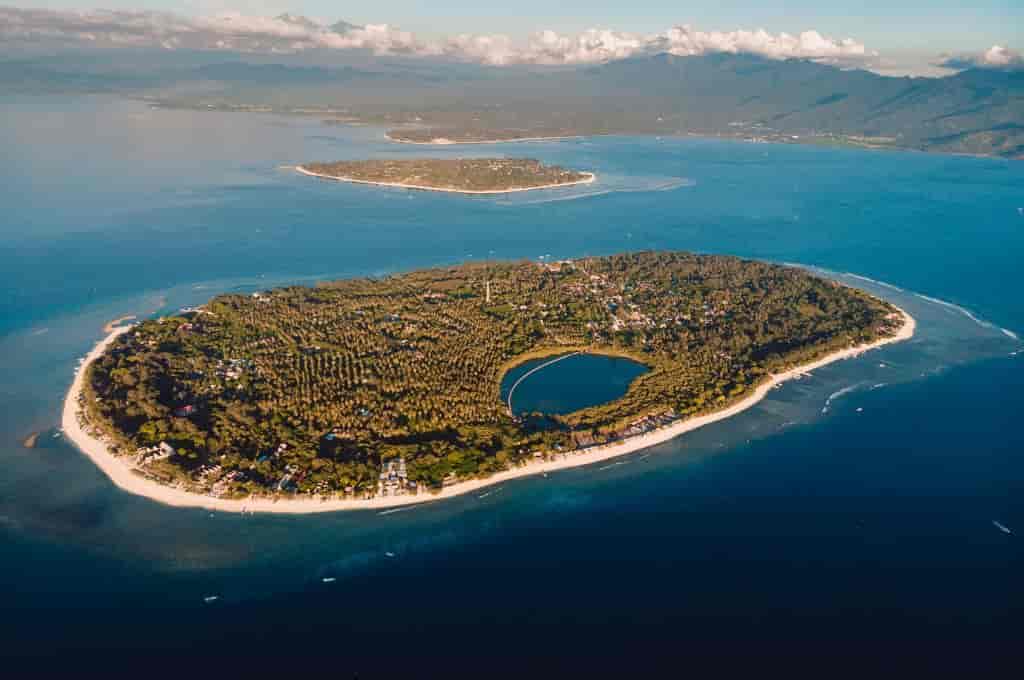
Best Time to Visit: The dry season, from May to October, is ideal for the Gili Islands, with July and August as the peak months. This time of year is the sunniest, with calm seas and excellent conditions for swimming, snorkelling, and diving.
How to Reach: Most tourists who visit the Gili Islands come from Bali. Fast boats departing from Padang Bai (East Bali), Sanur/Serangan (South Bali), and Amed (North Bali) take around 1.5-2 hours. Lombok’s airport is located in the centre of the island, about a two-hour drive from Bangsal, where most boats depart for Gili Trawangan. Gili Trawangan is only 10 to 15 minutes away by boat from Bangsal port.
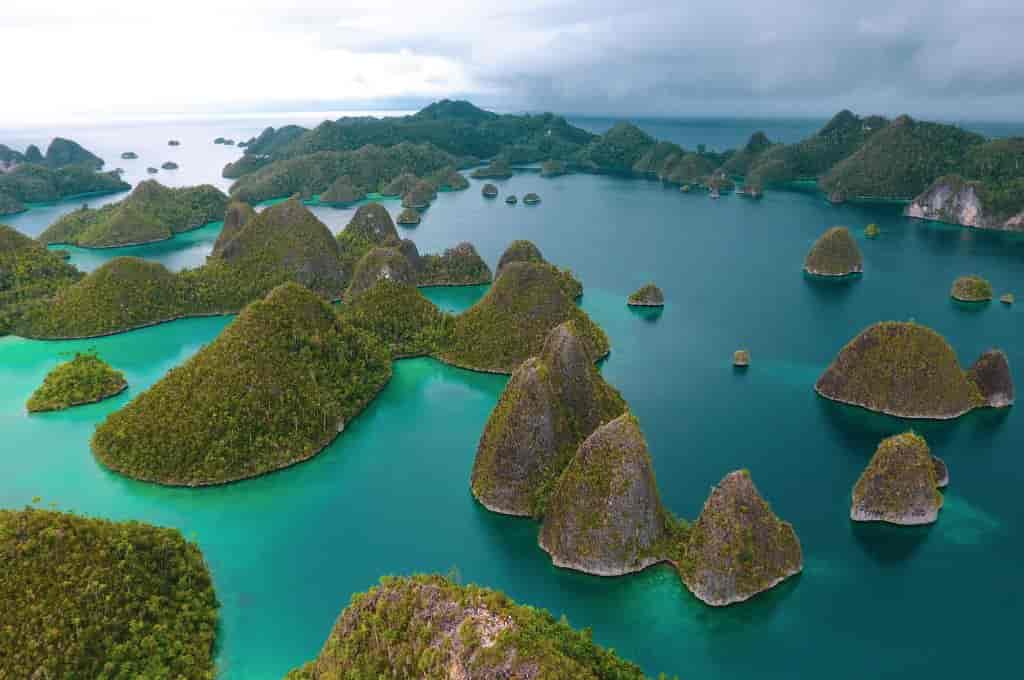
4. Raja Ampat, Indonesia
Raja Ampat, an archipelago located off the northwest coast of Papua, is a world-renowned destination for ecotourism and marine adventures. It is frequently referred to as one of the last untouched frontiers of natural beauty. Raja Ampat, which translates to “4 kings,” boasts surreal seascapes, emerald islets, tiny atolls, and some of the richest marine biodiversity on the planet. The region comprises approximately 1,500 jungle-smothered islets, cays, and shoals that rise from the sparkling turquoise waters and are flanked by vibrant coral reefs. The four main islands—Misool, Salawati, Batanta, and Waigeo—serve as key entry points for travellers. The latter is home to the region’s capital, Waisai, and the starting point for most visitors.
Located in the vibrant heart of the Coral Triangle, this region is the most biologically diverse habitat on earth and is rightly called the scuba destination of the world. With its crystal-clear waters teeming with manta rays, turtles, dugongs, giant clams, colourful coral reefs, quirky parrotfish, and countless fish species, the archipelago is an absolute treasure for snorkelers and divers.
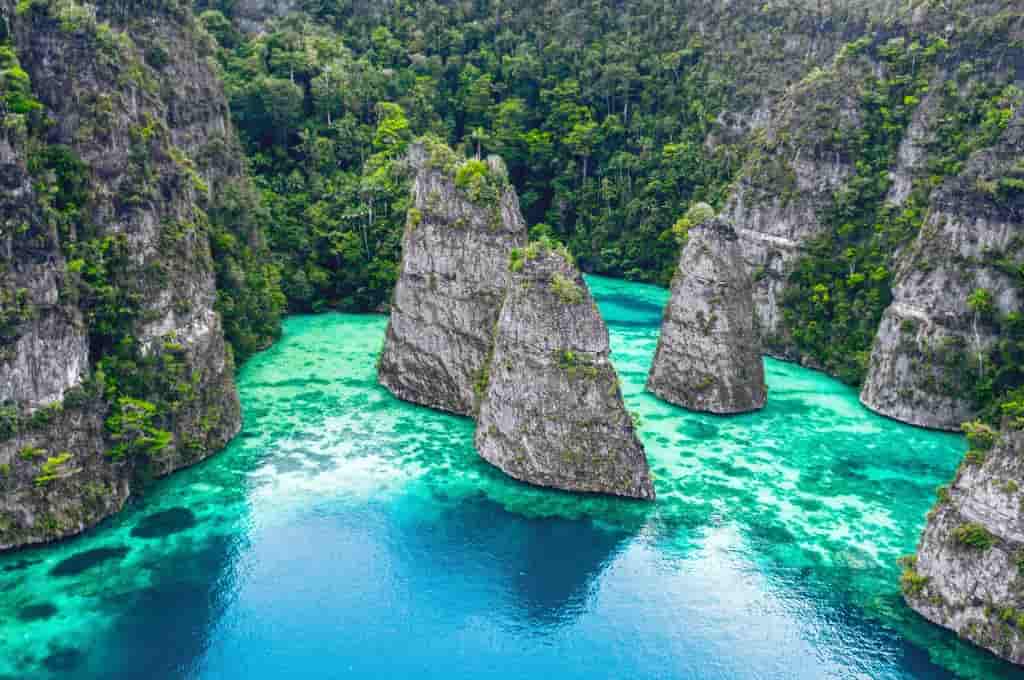
Beyond the aquatic attractions, the islands have rugged rock formations, lush rainforests, sizzling beaches, marshy lagoons, limestone karsts, and peaceful towns. Activities such as island hopping, birdwatching (particularly for the flamboyantly coloured Birds of Paradise), kayaking, and trekking add to the region’s appeal. Visitors can kayak past karst islets, explore the jungle, laze on white-sand beaches, bathe in waterfalls, discover ancient caverns, and experience traditional Papuan culture. Eco-resorts and homestays, many of which are run by local communities, offer sustainable and authentic accommodations.
Best Time to Visit: Due to its equatorial location, Raja Ampat is a year-round destination. However, Raja Ampat is best visited during the calm season, which usually lasts from September to April. The weather during these months is more consistent, with reduced humidity and rainfall. The calmer sea conditions and underwater visibility make it perfect for diving and snorkelling. In July and August, the usually tranquil seas may become turbulent, limiting or suspending diving.
How to Reach: Reaching Raja Ampat is not simple, but it is well worth the effort. The only way to get to Raja Ampat is to fly to Sorong in West Papua. Major cities in Indonesia, such as Jakarta, Ambon, Makassar, and Manado, offer flights to Sorong. From Sorong, you can take a ferry or speedboat to Waisai (the capital of Raja Ampat),
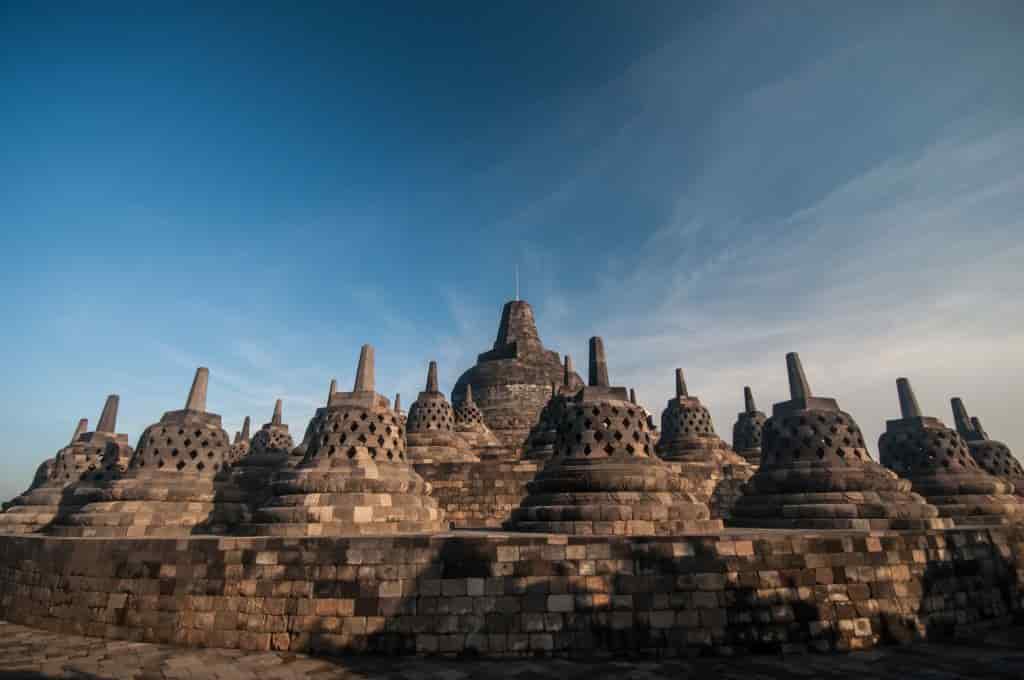
5. Java, Indonesia
Java is Indonesia’s commercial hub, with Jakarta serving as its capital. Java’s cultural diversity shines through in its traditional crafts, arts, and music, making it an excellent destination for unique cultural experiences. Yogyakarta is Java’s cultural heartbeat, combining traditional heritage, spiritual shrines, and modern ingenuity. The ancient temples of Borobudur and Prambanan, located near Yogyakarta, are UNESCO World Heritage Sites that draw visitors from around the world for their spectacular architecture and profound spiritual significance.
Borobudur, a nine-tiered temple dating back to the ninth century, is the world’s largest Buddhist structure, while Prambanan is Indonesia’s biggest Hindu temple complex. You can visit Sultan’s Place and immerse yourself in local culture by watching a Wayang Kulit (shadow puppetry) performance. The city is alive with creativity, and its streets are lined with murals, art spaces, charming boutiques, and an artistic vibe. The majority of Java’s attractions are located in the eastern region of the country. Tengger-Semeru National Park in East Java is home to five volcanoes situated close to each other. Mount Bromo, with its otherworldly landscape and dramatic sunrises, is a favourite among nature lovers and adventure seekers.

Banyuwangi serves as the starting point for the Ijen Crater, renowned for its blue fire and sulphur miners. Karimunjawa, an archipelago off the north coast of Central Java, is worth visiting. They are a group of 27 islands renowned for their postcard-perfect beaches, vibrant, rainbow-colored coral reefs, mangrove forests, and diverse marine life, which includes turtles and sharks. Other places not to be missed are the colourful village of Jodipan, the picturesque towns of Bandung and Dieng Plateau, and the Tumpak Sewu waterfall. For those interested in urban exploration, cities such as Jakarta, Yogyakarta, Bandung, and Surabaya offer an exciting blend of history, shopping, culinary delights, and vibrant nightlife.
Best Time to Visit: Java is best visited during the dry season, from May to October.
How to Reach: Soekarno-Hatta International Airport (CGK) in Jakarta is well connected to major cities worldwide. It is also a major domestic hub. Yogyakarta, Surakarta, and Bandung have limited international flights; however, they do offer regular connections from Jakarta. Juanda International Airport in Surabaya serves as an entry point to East Java. Once you land at one of these airports, you may easily find domestic flights/trains/ferries to other cities in Java.
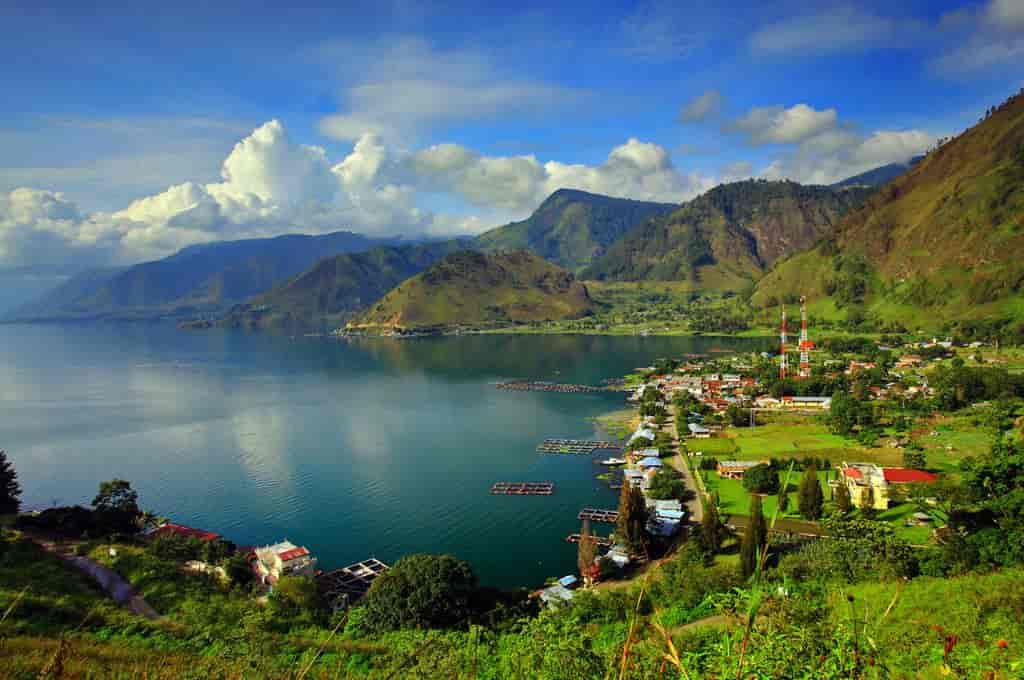
6. Sumatra, Indonesia
Sumatra, the world’s sixth-largest island, offers an exciting blend of natural wonders, wildlife-filled rainforests, and a unique cultural heritage, making it ideal for those seeking off-the-beaten-path adventures. The undiscovered paradise allows you to climb the summit of towering volcanoes, wade over tumbling waterfalls, unwind on untamed beaches, explore incredible underwater reefs, soak in the natural beauty, and delve into deep rainforests in search of wild animals.
One of the primary attractions is Lake Toba, the largest volcanic lake in the world, formed by a massive volcanic eruption thousands of years ago. This vast lake promises unparalleled tranquility, splendor, and excitement. Another must-see is Samosir, an island in Lake Toba, where visitors may experience the unique and rich culture and heritage of the Batak villages. Nearby attractions include the Sipiso-piso Waterfall and Bukit Lawang, where you can view orangutans in their natural habitat. Bukit Lawang serves as the gateway to Gunung Leuser National Park, a UNESCO World Heritage Site that protects rare and endangered species, including the Sumatran orangutan, tiger, elephant, and rhinoceros.
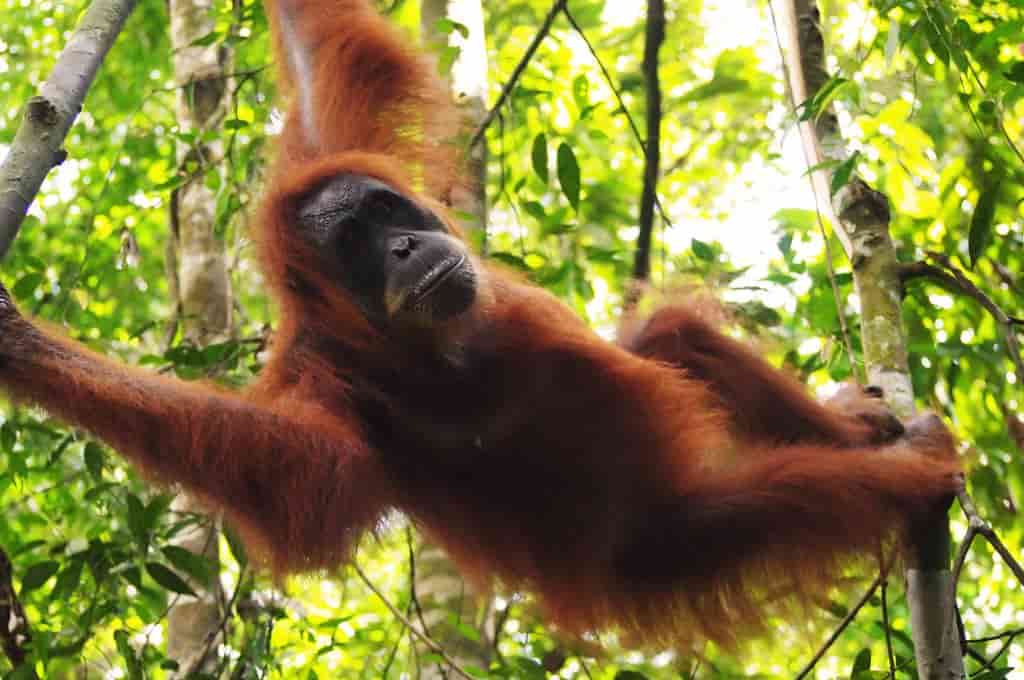
Aside from excellent wildlife sporting opportunities, you can also unwind on gorgeous beaches like Belitung on Sumatra’s East Coast, which is known for its exceptionally soft sand and tranquil waves. Belitung Island is also surrounded by over 100 tiny islands that are adorned with striking granite rock formations. Hiking enthusiasts could plan a trip to one of the island’s many volcanoes. Gunung Kerinci, Southeast Asia’s tallest volcano at 3805 metres above sea level, looms over a remote highland valley in Sumatra. Much of the terrain is part of Kerinci Seblat National Park, a sanctuary for Sumatran tigers. Sumatra’s cultural richness is evident in places such as Medan, Padang, and Bukittinggi, which are renowned for their colonial architecture, delectable cuisine, and strong Minangkabau traditions.
Best Time to Visit: April through October is the ideal time to visit Sumatra, particularly if surfing is a priority. The best time for wildlife sightings is during the dry season, from May to September.
How to Reach: The main flight hub for the island is Kualanamu International Airport in Medan, the capital city. The majority of flights arrive from Bangkok, Jakarta, Singapore, or Kuala Lumpur; therefore, you will need to change flights in Asia before traveling to Sumatra. Another option is to take a ferry from Java (Merak Port) to the Bakauheni port in Lampung. Sumatra is a large island, but fortunately, there are plenty of ways to get around, including trains, buses, ferries, taxis, and flights.
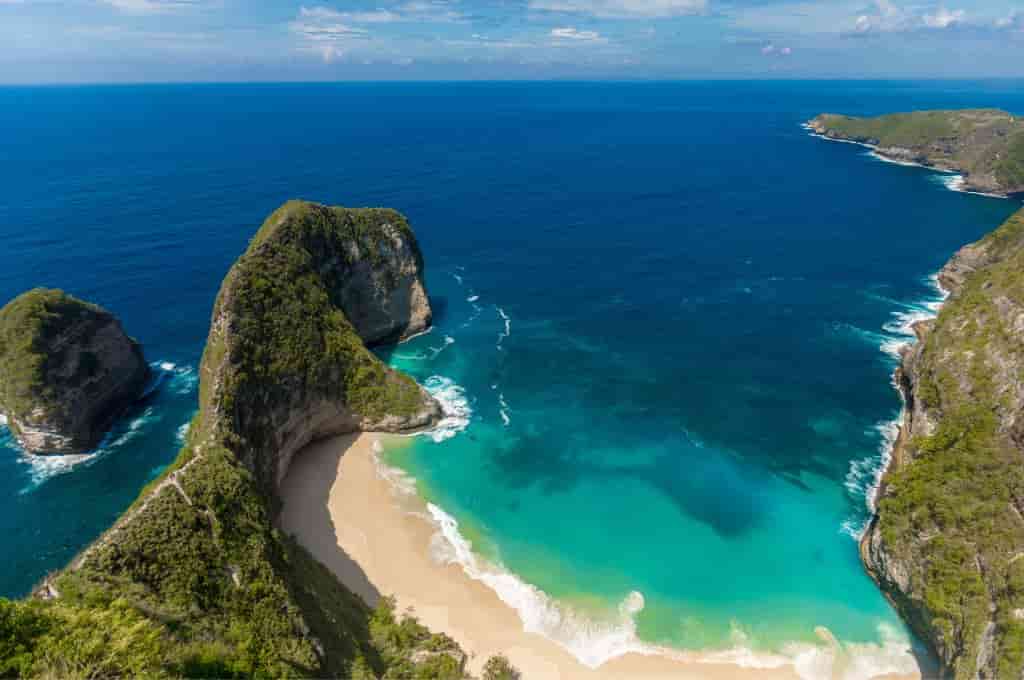
7. Nusa Islands, Indonesia
The Nusa Islands, comprising Nusa Penida, Nusa Lembongan, and Nusa Ceningan, are a trio of picturesque islands situated southeast of Bali. Due to their proximity to Bali, the Nusa Islands have quickly become a popular tourist destination for those seeking a more serene, rugged alternative to Bali. The largest of the three, Nusa Penida, is a sight to behold with its spectacular cliffy coastlines encircled by turquoise waters. It has a slew of iconic spots like Atuh Beach, Kelingking Beach, Diamond Beach, Angel’s Billabong, Broken Beach, and Goa Giri Putri Temple.
Nusa Penida is also a popular dive spot, particularly for those looking to encounter manta rays and the elusive mola mola (sunfish). Nusa Lembongan boasts a laid-back atmosphere, featuring mangrove forests, popular surfing spots, and beachside restaurants, as well as photogenic beaches like Mushroom Bay, Coconut Beach, Lago Beach, and Jungutbatu Beach. Snorkelling, kayaking, and surfing are popular with surfers and beach lovers looking for an idyllic beach vacation away from Bali’s crowds.
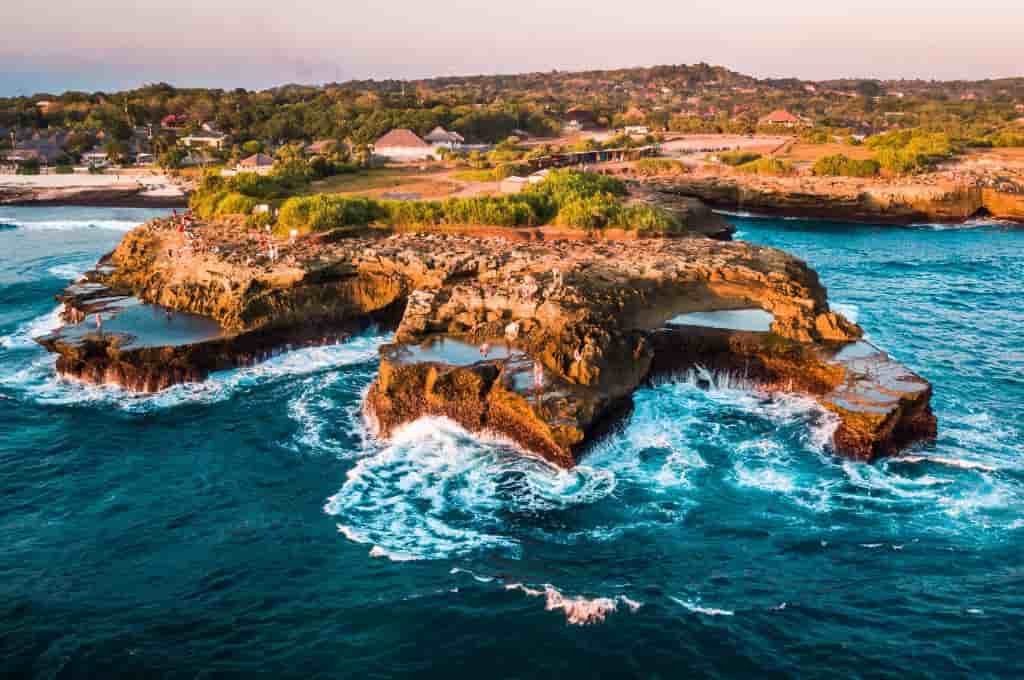
The Devil’s Tear is another popular sight on Nusa Lembongan. It is known as Devil’s Tears because of the enormous waves that crash on the rocky cliffs, causing dramatic plumes of water to explode from the ocean, resembling tears shed by a devil. The small and scenic Nusa Ceningan is linked to Lembongan by a yellow suspension bridge. It’s ideal for cliff jumping, discovering hidden coves, and admiring breathtaking views with fewer tourists. The islands offer a range of lodging options, from budget-friendly guesthouses to upscale cliffside resorts. If you don’t want to stay overnight on the islands, you can schedule day tours from Bali.
Best Time to Visit: The Nusa Islands are best visited during the dry season, which lasts from May to September. This time of year offers pleasant weather with less rain, more sunshine, and lower humidity, making it an excellent time for island exploration.
How to Reach: The easiest way to go to the Nusa Islands (Nusa Lembongan, Nusa Ceningan, and Nusa Penida) is by boat from Bali. You can take a fast boat or a ferry from multiple ports in Bali, with Sanur being the most favoured point.
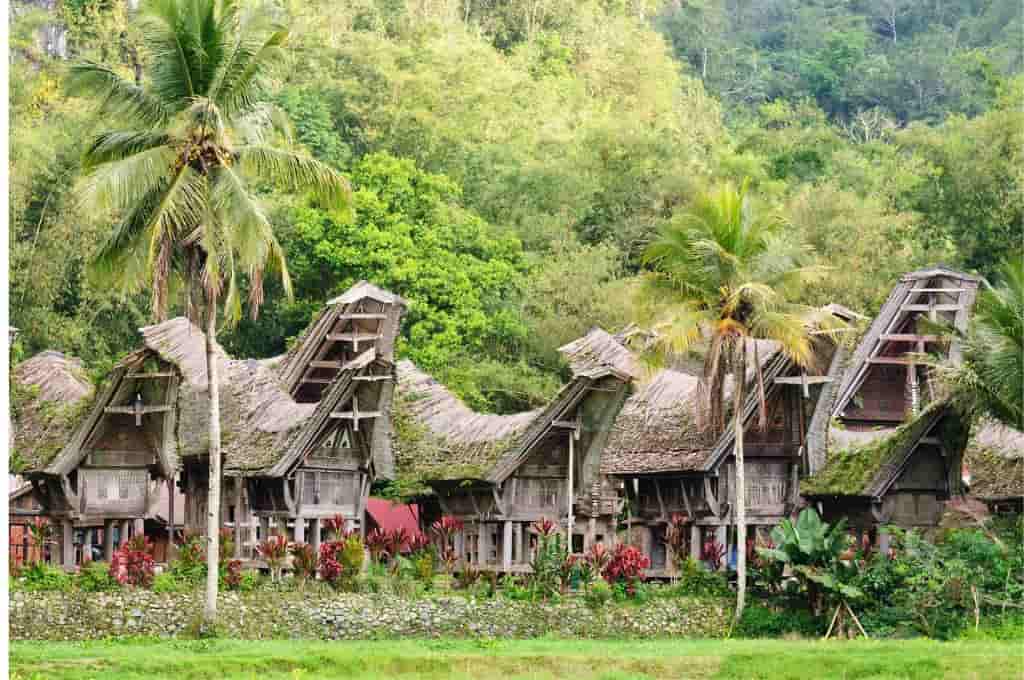
8. Sulawesi, Indonesia
Sulawesi, with its unusual orchid-like shape, is an intriguing blend of ancient traditions, distinct cultures, dramatic geology, and magnificent natural beauty. Whether you’re discovering tribal traditions, traversing through mysterious jungles, hiking steep mountains, or diving in crystalline waters, Sulawesi offers an unforgettable and intriguing Indonesian vacation. Visitors to Tana Toraja’s highlands are drawn to the region’s striking traditional dwellings (Tongkonan), elaborate funeral ceremonies, and cliffside burial sites, which provide deep insights into one of Indonesia’s most complex and fascinating cultures.
The Tana Toraja Highlands offer a rare glimpse into a culture that celebrates the delicate balance between life and death. The bodies of the departed might remain in their houses for months or even years after their death. From the extravagant funerals to cohabiting with and caring for the mummies of their deceased relatives, every facet of the Torrejon people reflects the complexity of their culture. The Togian Islands are a seascape paradise for individuals seeking tranquillity and secluded marine ecosystems. Bunaken National Marine Park, located just off the coast of North Sulawesi, is home to some of the world’s most vibrant coral reefs and marine wildlife. The site is a paradise for snorkelers and divers seeking to immerse themselves in an underwater panorama of dynamic coral gardens teeming with life.
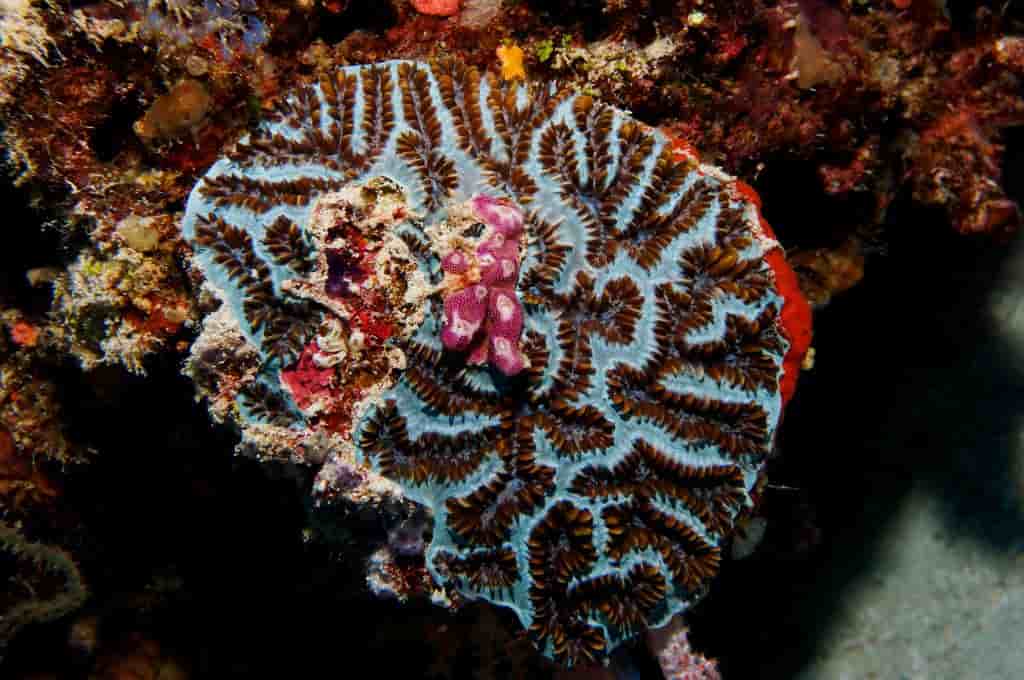
Sulawesi also boasts breathtaking volcanic vistas, pristine lakes like Lake Poso, and wildlife-rich rainforests that protect rare species, including the tarsier and anoa. Wakatobi is Asia’s largest reef, and the world’s second after the Great Barrier Reef. Divers believe it has the most ecologically diverse coral and marine life. Makassar, the capital city, serves as a convenient entry point, offering a dynamic blend of history, colonial architecture, and delectable seafood cuisine. The Minahasa Highlands and Lake Tondano in Sulawesi offer further trekking and cultural exploration opportunities.
Best Time to Visit: While you may visit Sulawesi at any time of year, most travellers choose to avoid the rainy months. This means that the optimum time to visit Sulawesi is during the dry season, which runs from May to October.
How to Reach: Makassar, the provincial capital of Sulawesi, has the most flights, including international connections to Kuala Lumpur and Singapore. There are flights to Makassar from several other Indonesian cities as well. Sulawesi’s hilly terrain makes traveling challenging, particularly in remote areas. Road conditions are often poor. Air travel is recommended whenever possible. While public transportation is available, renting a car or taking a local taxi is generally more convenient. Be prepared for extended travel hours between destinations.
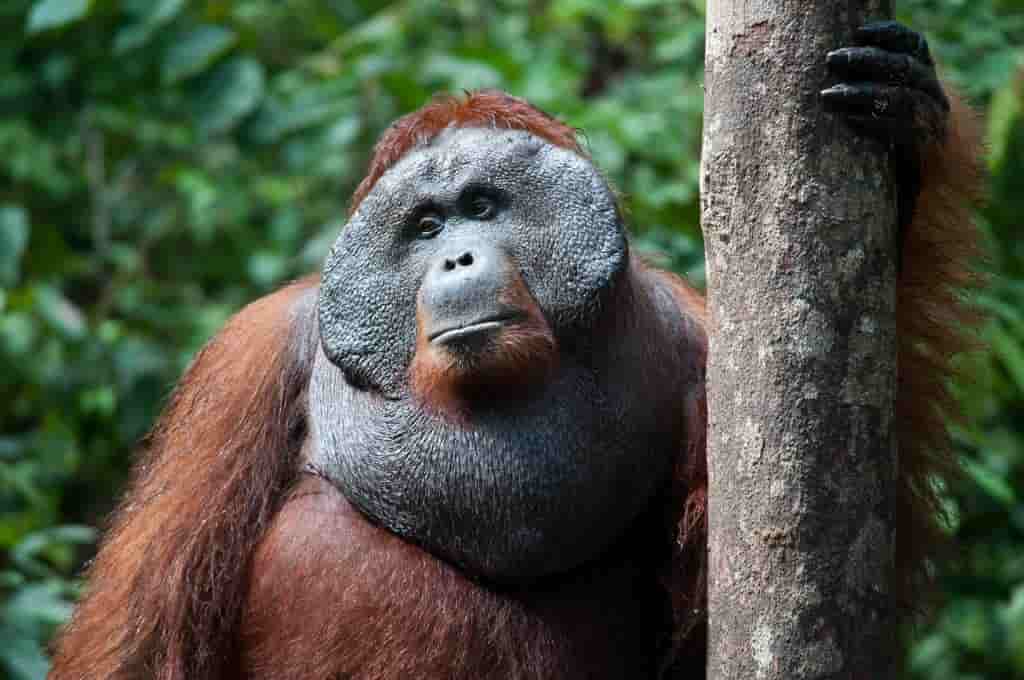
9. Tanjung Puting National Park (Borneo), Indonesia
Brunei, Malaysia, and Indonesia all share the island of Borneo. It is a vast and ecologically diverse region, ideal for nature lovers, explorers, and eco-tourists seeking wilderness, cultural authenticity, and meaningful, environmentally centred exploration. Tanjung Puting is a National Park and the thickest jungle of Kalimantan, Indonesia, a part of Borneo. Travelers head to Tanjung Puting National Park for surefire sightings of endangered Bornean orangutans. It is primarily a swamp and mangrove forest, offering an Amazon-like experience that is much closer to home. Take a river safari on a traditional boat (Klotoks) and wind along the Sekonyer River, encountering proboscis monkeys, Clouded Leopards, Malaysian sun bears, barking deer, Jenie Subaru, unusual bird species, and, of course, the Bornean orangutans.
The mammal is the primary reason why hundreds of tourists visit this region of Indonesia. Tanjung Puting National Park is recognized for its orangutan rehabilitation operations. You may see these fascinating primates at Camp Leakey, a rehabilitation facility where they live a happy, semi-wild life. Beyond the wildlife, Kalimantan offers a wealth of culture through visits to traditional Dayak communities, where tourists can discover longhouse architecture, local craftsmanship, and indigenous customs. If you’re looking for more adventure, consider taking a boat ride down the Mahakam River in East Kalimantan to explore floating villages.
Best Time to Visit: Kalimantan is best visited during the dry season, which runs from June to September. During this time, the orangutans of Tanjung Puting National Park are typically the most active and easiest to spot.
How to Reach: To reach Tanjung Puting National Park in Borneo, fly to Pangkalan Bun. Pangkalan Bun’s Iskandar Airport can be reached by air from major Indonesian cities, like Jakarta, Surabaya, and Semarang. From Pangkalan Bun, you’ll go by boat to reach the park’s interior
